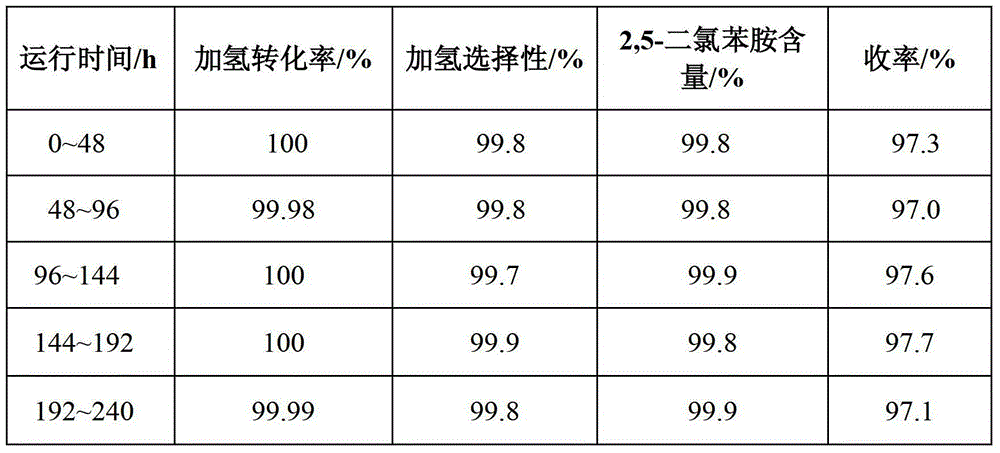Production method of 2,5-dichloroaniline
A technology of dichloroaniline and its production method, which is applied in the field of hydrogenation of 2,5-dichloronitrobenzene to prepare 2,5-dichloroaniline, which can solve the difficulty of increasing post-processing equipment investment, recovering energy consumption, and increasing operation and safety hazards, reducing production safety and cleanliness, etc., to achieve the effects of increasing production capacity and equipment utilization, improving stability and safety, and reducing production costs and equipment investment
- Summary
- Abstract
- Description
- Claims
- Application Information
AI Technical Summary
Problems solved by technology
Method used
Image
Examples
Embodiment 1
[0023] Three stainless steel autoclaves are connected in series. The volumes of the three reactors are 100L, 50L, and 50L respectively. The effective volume of the entire hydrogenation system is 140L (including the catalyst filtration circulation system).
[0024] Add 60L, 30L, and 30L of 2,5-dichloronitrobenzene into the three-stage reactor respectively, and at the same time add 3.8kg, 1.9kg, and 1.9kg of 1wt% platinum / carbon catalyst wet base respectively, and feed the system after replacement Hydrogen to the reaction pressure of 0.8MPa, raise the temperature and control the reaction temperature at 80-90°C, carry out the hydrogenation reduction reaction under this condition for 5h, until the conversion of 2,5-dichloronitrobenzene is complete.
[0025] Turn on the metering pump to continuously feed 2,5-dichloronitrobenzene and ammonia water into the primary kettle, the feed flow rate of 2,5-dichloronitrobenzene is 24L / h, and the feed flow rate of ammonia water is 20mL / h. Keep...
Embodiment 2
[0028] Three stainless steel autoclaves are connected in series. The volumes of the three reactors are 100L, 50L, and 50L respectively. The effective volume of the entire hydrogenation system is 140L (including the catalyst filtration circulation system). React according to the continuous process of embodiment 1, in order to investigate the stability of process, run continuously 240h with above-mentioned method, in the process, product yield and reaction conversion rate, selectivity are measured every 48h of running, test result is as follows.
[0029]
[0030] It can be seen from the above table that under the conditions of 80-90°C and 0.8 MPa, the hydrogenation conversion rate of 2,5-dichloronitrobenzene basically reaches 100%, and the selectivity reaches more than 99.8%. The content is more than 99.5%, and the yield is more than 97%.
Embodiment 3
[0032] Four stainless steel autoclaves are connected in series. The volumes of the four reactors are 100L, 100L, 50L, and 50L respectively. The effective volume of the entire hydrogenation system is 200L (including the catalyst filtration circulation system).
[0033]Add 60L, 60L, 30L, and 30L of 2,5-dichloronitrobenzene into the three-stage reactor respectively, and simultaneously add 1wt% platinum / carbon catalyst wet base 3.8kg, 3.8kg, 1.9kg, 1.9kg, After the system is replaced, hydrogen gas is introduced to the reaction pressure of 0.8MPa, the temperature is raised and the reaction temperature is controlled at 80-90°C, and the hydrogenation reduction reaction is carried out under this condition for 4.5 hours until the conversion of 2,5-dichloronitrobenzene is complete.
[0034] Turn on the metering pump to continuously feed 2,5-dichloronitrobenzene and ammonia water into the primary kettle, the feed flow rate of 2,5-dichloronitrobenzene is 40L / h, and the feed flow rate of am...
PUM
 Login to View More
Login to View More Abstract
Description
Claims
Application Information
 Login to View More
Login to View More - Generate Ideas
- Intellectual Property
- Life Sciences
- Materials
- Tech Scout
- Unparalleled Data Quality
- Higher Quality Content
- 60% Fewer Hallucinations
Browse by: Latest US Patents, China's latest patents, Technical Efficacy Thesaurus, Application Domain, Technology Topic, Popular Technical Reports.
© 2025 PatSnap. All rights reserved.Legal|Privacy policy|Modern Slavery Act Transparency Statement|Sitemap|About US| Contact US: help@patsnap.com

